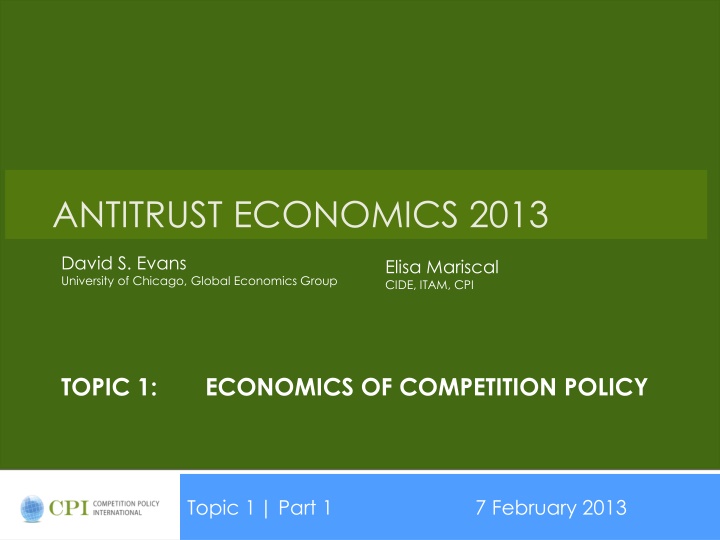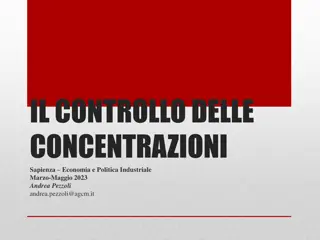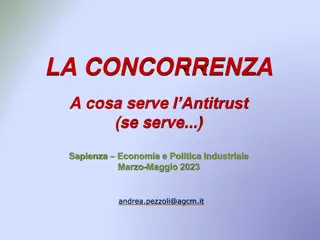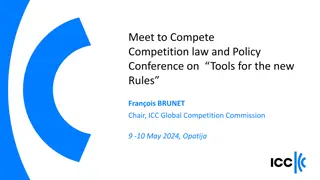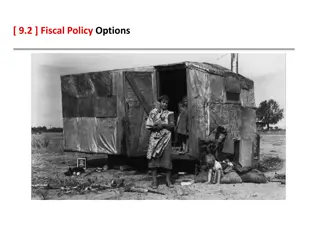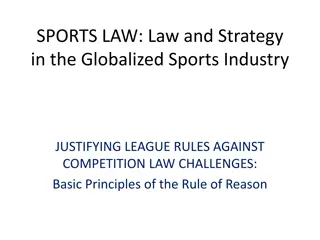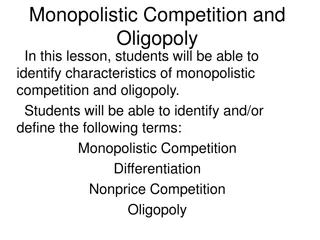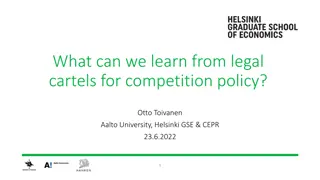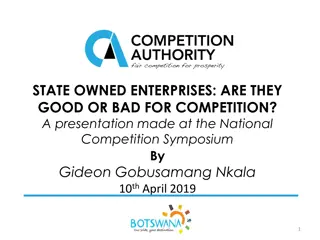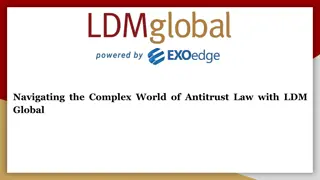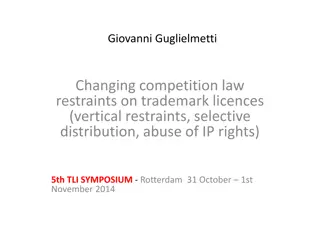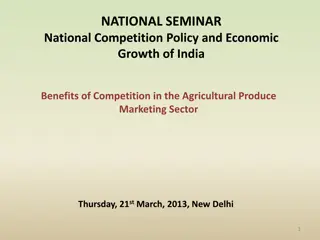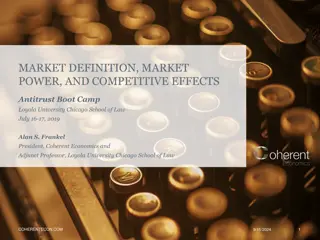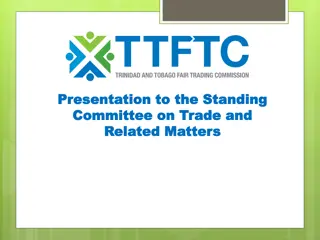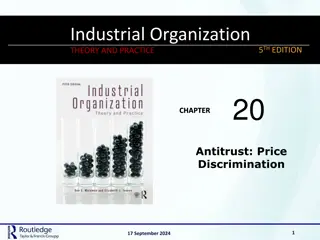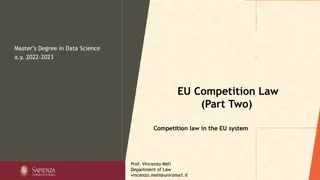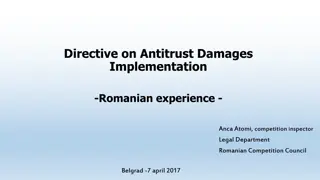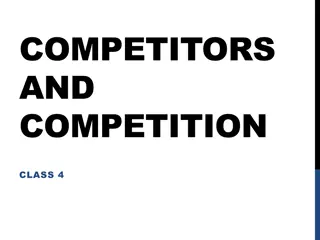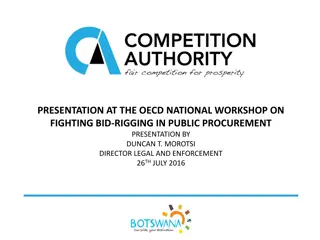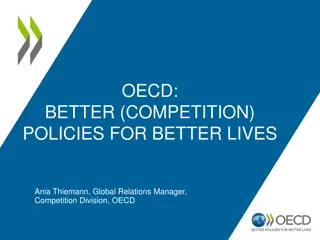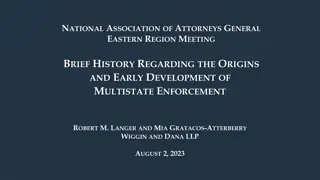Economics of Competition Policy in Antitrust Practice
Understanding the importance of economics in antitrust practice is crucial as it involves applying economic concepts like markets, competition, and market power. Economists play a significant role in developing case theories and evidence, making economics indispensable in dealing with competition agencies, hiring economists, and presenting economic arguments in courts globally.
Download Presentation

Please find below an Image/Link to download the presentation.
The content on the website is provided AS IS for your information and personal use only. It may not be sold, licensed, or shared on other websites without obtaining consent from the author.If you encounter any issues during the download, it is possible that the publisher has removed the file from their server.
You are allowed to download the files provided on this website for personal or commercial use, subject to the condition that they are used lawfully. All files are the property of their respective owners.
The content on the website is provided AS IS for your information and personal use only. It may not be sold, licensed, or shared on other websites without obtaining consent from the author.
E N D
Presentation Transcript
ANTITRUST ECONOMICS 2013 David S. Evans University of Chicago, Global Economics Group Elisa Mariscal CIDE, ITAM, CPI TOPIC 1: ECONOMICS OF COMPETITION POLICY Topic 1| Part 1 7 February 2013 Date
Overview 2 Part 1 Part 2 The importance of economics to the practice of antitrust The basic economics of competition policy How is the course going to help you learn antitrust economics The design of competition rule Competition and why we care about it
3 Economics and Antitrust Practice The importance of economics to the practice of antitrust
Antitrust based on and applies economic ideas 4 Antitrust involves the application of economic concepts such as markets, substitution, competition, market power, vertical restraints, and so forth. These are the subjects of a branch of economics known as industrial organization and of microeconomics more generally. Most areas of the law, by contrast, involve the application of legal reasoning and principles to a set of facts. A court examining a breach of contract for the construction of a bridge applies contract law and not bridge engineering.
Economics lingua franc for antitrust globally 5 The case law and decisional practice have focused increasingly on economic questions. Economic theory and empirical methods can help answer those questions and economists are often called on to do so by the agencies, the parties, and sometimes even the courts. Globally, there is increasing faith in social benefits of markets. This has led to greater reliance on economics for understanding how markets work.
Why know antitrust economics? 6 You will have to deal with economists at the main competition agencies: DG Comp, US DOJ, FTC, ACCC, CADE, MOFCOM, You will have to hire and interact with economists for your case and counter those working for your adversaries. You will increasingly have to deal with economic arguments before the administrative and judicial courts. Economics plays a critical role in helping develop the theory of the case and assembling evidence to support this theory.
Economic ideas have wide influence 7 Practical men, who believe themselves to be quite exempt from any intellectual influences, are usually the slaves of some defunct economist. Keynes, 1936
Economists: current and recent authority officials 8 Joshua Wright Joaquim Almunia Commissioner currently in charge of competition policy Mario Monti Eduardo Perez Motta John Fingleton Dongsoo Kim Elizabeth Farina FTC Commissioner previously in charge of competition policy President of Mexican Federal Competition Commission Former head of the UK Office of Fair Trading Chairman Korean Fair Trade Commission Former President of CADE, Brazil Commissioner Many authority heads and officials are Ph.D. economists and former economics professors
Most key authorities have a chief economist 9 Some examples from around the world Howard Shelanski Fiona Scott Morton Kai-Uwe Kuh Thibaud Verge Simon Roberts Jarig van Sinderen Aleksey Sushkevich Chief Economist, South Africa Competition Commission Director, Bureau of Economics, FTC Deputy Assistant Attorney General, US Department of Justice Chief Economist French Competition Authority Chief Economist Netherlands Competition Authority Head of Analytical Department, Federal Antimonopoly Service, Russian Federation Chief Economist, European Commission The chief economist often has a significant influence on investigations and outcomes
Many economists at the agencies on cases 10 Examples from around the world US Federal Trade Commission: 70+ Ph.D. economists Antirust Division, US Department of Justice: 50+ Ph.Ds DG Comp, European Commission: 200 have background in economics, 20+ Ph.Ds in economics Bundeswettbewerbsbeho rde, Austria: 7 economists CADE, Brazil: around 30 economists CFC, Mexico: operating staff around 50% economists Competition Bureau, Canada: 8 Ph.D. economists
Economics is used in enforcement guidelines 11 Examples from around the world number of quantitative tests that have specifically been designed for the purpose of delineating markets. These tests consist of various econometric and statistical approaches: estimates of elasticities and cross-price elasticities for the demand of a product, tests based on similarity of price movements over time, the analysis of causality between price series and similarity of price levels and/or their convergence. EC Commission's Market Definition guidelines MOFCOM concluded that the transaction would reduce the competitive pressures on HDD manufacturers in terms of pricing in bidding procedures organized by computer manufacturers. It also considered the increased risk of coordination between the remaining competitors MOFCOM Decision regarding the Seagate/Samsung merger If there are sufficient data to analyze the impact of a challenged business practice, the change in the level of prices and profits before and after the imposition of the practice can be used to assess the change in market power. It is important to control for the impact on market power of changes in relevant competitive factors, such as costs or the extent of competition from other firms, that are taking place at the same time. Reference Document for the Determination of Substantial Market Power, Mexico
Economics is referred to in the decisions 12 Examples from around the world Use of merger simulation and diversion ratios (within a one-level nested logit model) to clear the merger subject to conditions. Unilever/Sara Lee Body Care EU, 2010 The Commission calculated diversion ratios and likely post-merger price increases to recommend to the Tribunal that the merged entity divest a brand to an independent player. The Tribunal concurred. Unilever/Sara Lee South Africa The CC used a Gross Upward Price Pressure Index (GUPPI) as a quantitative indicator to assess closeness of competition between the two companies. Zipcar/Streetcar UK, CC 2010 The operation would lead Nestl to increase prices in infant formula within a range of 2.9 and 11.5%, and a similar response by other competitors. Nestl /Pfizer merger Mexico, 2012
Economics is referred to by the courts 13 Economics literature is replete with procompetitive justifications for a manufacturer s use of resale price maintenance, and the few recent studies on the subject also cast doubt on the conclusion that the practice meets the criteria for a per se rule. There is no evidence showing that the actual market competition was prevented or that such calculation of the annual demand volume was intentionally manipulated Such profits are appropriate and there is nothing wrong with this in the context of the Anti- Monopoly Law. Rokumi Sangyo v. Hinode Suido, et al., 2006. Intellectual Property High Court (IPHC), Japan Leegin Creative Leather Products, Inc. v. PSKS, Inc., 551 U.S. 877 (2007) U.S. Supreme Court
Economic ideas a core of most cases 14 Merger what is the relevant market, competitive constraints, likely competitive effect of merger on prices, quality, and innovation. Cartel in the absence of a smoking gun do pricing patterns show evidence of collusion; by how much did prices increase because of cartel? Abuse of Dominance did actions foreclose significant competition and lack efficiency explanations? Answering these economic questions often involves a combination of economic theory and empirical analysis, sometimes quite sophisticated, sometimes not.
Economics has become a powerful force 15 Antitrust law has focused increasingly on economic questions Economic theory and empirical methods can help answer those questions Increasing faith (despite recent crisis) in power of markets to help society and therefore greater reliance on economic understanding of competition
Economic revolution in antitrust 16 Began to influence court decisions in the US in the late 1970s based on work largely begun in the 1950s. Has expanded in the US and other jurisdictions ever since. Now a consensus in the EU, US, and many other jurisdictions that the central focus of antitrust is the welfare of the consumer. Economics is key for analyzing consumer impact.
Some questions to discuss over lunch 17 Can you think of other areas of law in which the legal concepts are so intertwined with another discipline? Competition laws question whether firms can merge but not whether they can grow very large organically. Does that make sense and why? Executives are more likely to go to jail and for longer for insider trading than for participating in a cartel. Is that a sensible outcome and if not why has this happened?
Course Overview 18 How is the course going to help you learn antitrust economics
Give you tools and show you how to apply 19 First objective is to introduce you to the economic tools you need for examining antitrust Second objective is to show you how to apply those tools to specific topics that arise in antitrust
Course to help you think like an economist 20 The course is designed to teach the fundamentals of economics and help you to start thinking like an economist. It is not designed to give you a cookbook of a compendium of received wisdom. It builds economics from the ground up so you can appreciate its strengths and weaknesses
Eight topics on antitrust economics tools 21 1. Economics of competition policy Module 1 2. Firms and profit maximization 3. Demand, supply, and static competition 4. Innovation and dynamic competition 5. Product differentiation 6. Competition, market failures and welfare 7. Multi-sided platform economics 8. Game theory and oligopoly
Eight topics on applying antitrust tools 22 9. Cartels and coordinated effects Module 2 10. Competitive constraints and market power 11. Market definition 12. Horizontal mergers and competitive effects 13. Predatory and other pricing strategies 14. Vertical relationships and integration 15. Vertical restraints 16. Antitrust and intellectual property
Reading material and course preparation 23 Suggested textbook is Carlton and Perloff s Modern Industrial Organization Similar coverage is found in other industrial organization textbooks. Also useful to have a basic economics textbook such as Mankiw. Most readings based on articles which are available online Those with * are required. Others you might peruse or use for deeper study or as reference.
Your CPI teaching team 24 Professor David S. Evans devans@globaleconomicsgroup.com devans@globaleconomicsgroup.com Professor Elisa Mariscal emariscal@competitionpolicyinternational.com emariscal@competitionpolicyinternational.com Course and IT support Mr. Jason Ohsie Teaching assistant Mr. Alexis Pirchio johsie@competitionpolicyinternational.com johsie@competitionpolicyinternational.com apirchio@competitionpolicyinternational.com apirchio@competitionpolicyinternational.com
Where to find things and other details 25 Reading list and related material https://www.competitionpolicyinternational.com/antitrust-economics-course-reading-list https://www.competitionpolicyinternational.com/antitr ust-economics-course-reading-list https://www.competitionpolicyinternational.com/antitrust-economics-course-reading-list Recording of lectures will be posted 4 days after each lecture https://www.competitionpolicyinternational.com/antitrust-economics-course-lectures https://www.competitionpolicyinternational.com/antitr ust-economics-course-lectures https://www.competitionpolicyinternational.com/antitrust-economics-course-lectures
Certification 26 CPI Certificate of Completion for Antitrust Economics CPI Mastery in Antitrust Economics Certificate CPI Mastery with Honors in Antitrust Economics Attend at least 24 live courses View all 32 lectures Yes, we know Passing grade on exam Honor grade on 3000 word essay Pass 2-hour multiple choice exam given 4 weeks after the end of Module 2
Static versus Dynamic Competition 27 The role of static and dynamic competition in antitrust analysis
Competition has two meanings, both important 28 Competition in the market: The existence of multiple firms that seek consumer business and offer consumer choice. This is also called static competition. Competition for the market: The act of striving against another force for the purpose of achieving dominance or attaining a reward or goal. This is also called dynamic competition.
Static competition between firms 29 Each firm sets price to attract customers from other firms in the market that produce substitutable (interchangeable) products. Product characteristics are set so firms cannot change the quality or characteristics of their products. Firms cost structures are set so they cannot expand capacity; cannot lower costs through improved technology or management.
Static competition mainly about price 30 Firms try to win market share by charging a low price. Competition drives price down so that it just covers cost and offers a competitive return on capital.
More competition, lower price, greater output 31 When many firms vie for consumer demand they tend to compete price down to the lowest efficient level. More consumers can afford to buy at lower prices so competition tends to increase output. Depending on market circumstances society can get the benefits of competition with a few firms competing with each other.
Static competition and the invisible hand 32 Every individual...generally, indeed, neither intends to promote the public interest, nor knows how much he is promoting it. By preferring the support of domestic to that of foreign industry he intends only his own security; and by directing that industry in such a manner as its produce may be of the greatest value, he intends only his own gain, and he is in this, as in many other cases, led by an invisible hand to promote an end which was no part of his intention. Adam Smith, Wealth of Nations, 1776.
Dynamic competition for leadership 33 Firms race to secure leading position By being first to market with a product or service (iPhone) By finding a niche (left-handed guitars) By creating a brand (Lexus) By coming up with new idea for product or service or way for producing something more cheaply (search-based advertising) Firms try to stave off rivals to recover their investments and risk taking First-mover advantages Intellectual property rights Switching costs Entry barriers such as economies of scale and network effects
Dynamic competition mainly about new features 34 Firms try to win category share by introducing new features through incremental innovation that differentiate them from rivals. Firms engage in drastic innovation to create new products and dominate new categories.
Dynamic competition, innovation, efficiency 35 More competition for the market leads to more innovation and greater efficiency in the long run The prospect of monopoly profits induces risky investment and innovation. Even though most efforts fail, firms race to come up with the next great idea. Society benefits enormously from new products and services that come from these efforts. Society also benefits when firms come up with innovations that enables them to produce things more cheaply.
Large rewards central to dynamic competition 36 Like lotteries most entrepreneurs who play the dynamic game of competition lose. There has to be a (large) prize for those who win to get entrepreneurs to play the game.
Dynamic competition and creative destruction 37 the perennial gale of creative destruction strikes not at the margins of the profits of the existing firms but at their foundations and their very lives. Joseph A. Schumpeter, Capitalism, Socialism and Democracy, 1942.
End of part 1, next week part 2 38 Part 1 Part 2 The importance of economics to the practice of antitrust The basic economics of competition policy How is the course going to help you learn antitrust economics The design of competition rule Competition and why we care about it
